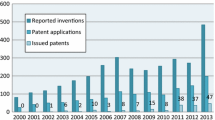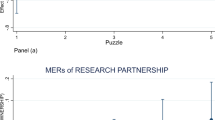Abstract
Brazil is considered to have an immature national innovation system. One significant situation that contributes to it is that Brazil concentrates its research efforts and inventiveness in academic environments, while the private sector has very little access to this activity. Measures are being taken to correct this situation. Nevertheless, scientists' attitudes towards the new situation will be instrumental for the success of such measures. For this reason, we have studied the behavior of Brazilian scientists from the biotechnological fields concerning Intellectual Property Rights. In this research 1032 researchers were electronically contacted and 150 responded. The 41 questions include indicators about the interviewees' perceptions about their institutions' support for patenting research results, their attitudes towards recent changes in Intellectual Property Rights legislation and about the interaction of researchers with demands from external interests.
Similar content being viewed by others
References
BALBACHEVSKY, E., QUINTEIRO, M. C. (2002), The changing academic workplace in Brazil. In: ALTBACH, P. (Ed.), The Decline of the Guru: The Academic Profession in Developing and Middle-Income Countries.
BALBACHEVSKY, E. (1999), A profissão acadêmica no Brasil: as mÚltiplas facetas do nosso ensino superior. Brasília: FUNADESP.
BLUMENTHAL, D., CAMPBELL, E. G., CAUSINO, N., LOUIS, K. S. (1997), Withholding research results in academic life science. Evidence from a national survey of faculty. JAMA, 277 (15): 1224-1228.
BOZEMAN B. (2000), Technology transfer and public policy: a review of research and theory. Research Policy, 29 (627-655).
CAMPBELL, E. G., WEISMANN, J. S., CAUSINO, N., BLUMENTHAL, D. (2000), Data withholding in academic medicine: characteristics of faculty denied access to research results and biomaterials. Research Policy, 29: 303-312.
COUTINHO, M. et al. (2003), O Apoio Institucional à População Pioneira de Cientistas Patenteadores nas Ciências Biológicas no Brasil, forthcoming.
FALCONI, C., SALAZAR, S. (1999), Report on the Workshop: Identifying the Needs for Managing Intellectual Property in Latin America. Costa Rica, 23-24 September 1999. International Service for National Agricultural Research (ISNAR), Discussion Paper.
FUJISUE, K. (1998), Promotion of academia-industry cooperation in Japan-establishing the law of promoting technology transfer from university to industry in Japan. Technovatioin, 18 (6-7): 371-281.
HOWELLS, J., MCKINLAY, C. (1999), Commercialisation of University Research in Europe-Final Report. Report to the Expert Panel on the Commercialisation of University Research for the Advisory Council on Science and Technology, Ontario, Canada.
LEE, Y. S. (1996), ‘Technology transfer’ and the research university: a search for the boundaries of university-industry collaboration. Research Policy, 25: 843-863.
LEE, Y. S. (2000), The sustainability of university-industry research collaboration: An empirical assessment. Journal of Technology Transfer, 25: 111-133.
LICHT G., NERLINGER, E. (1998), New technology-based firms in Germany: a survey of the recent evidence. Research Policy, 26 (9): 1005-1022.
MASSING, D. E. (Ed.) (1997), AUTM report, licensing survey, FY 1997. The Association of University Technology Managers.
MOWERY, D. C., Nelson, R., Sampat, B., Ziedonis, A. (2001), The growth of patenting and licensing by US universities: an assessment of the effects of the Bayh-Dole act of 1980. Research Policy, 30 (1): 99-119.
NELSON, R., WINTER, S. G. (Eds) (1993), National Innovation Systems: A Comparative Analysis. New York: Oxford University Press.
OFFICE OF TECHNOLOGY POLICY-Technology Administration-U.S. Department of Commerce. TECH TRANSFER 2000: MAKING PARTNERSHIPS WORK. February 2000.
PATEL, P., PAVITT, K. (1994a), The Nature and Economic Importance of National Innovation Systems. STI review. No. 14. OECD.
PATEL, P., PAVITT, K. (1994b), National innovation systems: why they are important, and how they might be measured and compared. Economics of Inovation and New Technology, 3 (1): 77-95.
SCHWARTZMAN, S. (2001), Um espaço para a ciência-a formação da comunidade científica no Brasil. Brasília: Ministério de Ciência e Tecnologia, Centro de Estudos Estratégicos.
Author information
Authors and Affiliations
Corresponding author
Rights and permissions
About this article
Cite this article
Coutinho, M., Balbachevsky, E., Holzhacker, D.O. et al. Intellectual property and public research in biotechnology: the scientists opinion. Scientometrics 58, 641–656 (2003). https://doi.org/10.1023/B:SCIE.0000006885.67651.9e
Issue Date:
DOI: https://doi.org/10.1023/B:SCIE.0000006885.67651.9e




